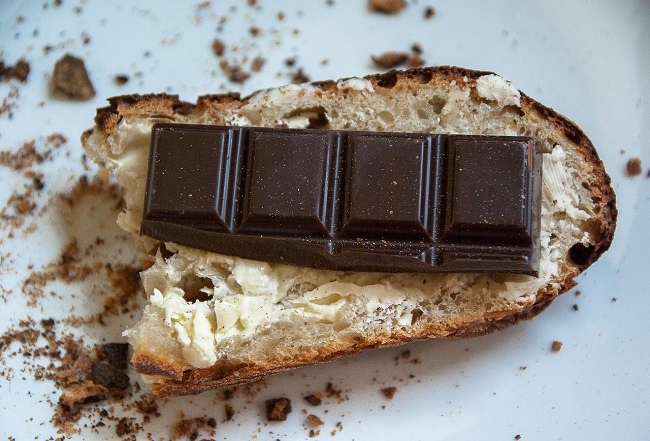By Raeleen D’Agostino Mautner
When Italian Americans look around their homes, visible signs of their heritage show up everywhere. In my home, for instance, on one wall a portrait by zio Michele of Girifalco (CZ); on another a needlepoint likeness of Padre Pio by cugina Concetta; baskets woven by my elder zie of Castelpagano (BN), a holy statue carried here in my grandmother’s suitcase from Trapani. Added to the artifacts are piles of photo albums capturing my own times in Italy, from the coursework I did there as a college student, to visiting family along the years, or more recently, giving presentations or book signings.
But perhaps one of the most important albeit INtangible ways we learned from our immigrant forebearers on how to stay connected to our Italian roots—besides the preservation of their dialects—was to in some way preserve their cuisine.
Food, nostalgia, and cultural heritage are inextricably woven together, according to historians. The preparation of traditional dishes from their local Italian villages played an important role in preserving the ethnic and cultural identity of Italian immigrants in America. The continuation of these dishes gives successive generations a way to remain connected to our ancestral roots, and to re-experience the comfort and warmth of the people we associate with them. Perhaps your mother made you pastina with a little butter and grated parmesan when you weren’t feeling well. Your grandmother might have prepared a hearty bowl of what some today refer to as “peasant food”, albeit priced for nobility in today’s Italian restaurants—pasta e ceci; pasta e patate; or fagiolini al pomodoro con patate, which you sopped up with a hunk off the crusty round loaf that came straight from the oven to fare la scarpetta.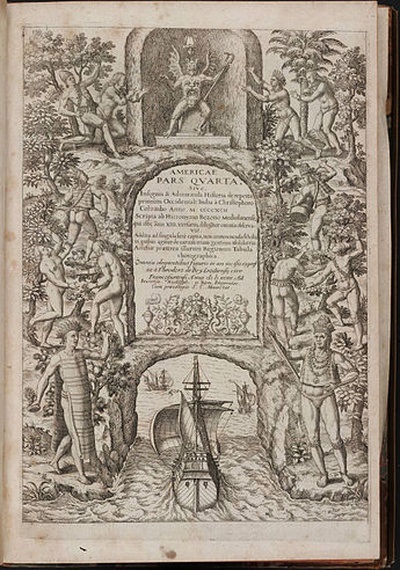
One special memory for me is the pane e cioccolata I use to share with my grandfather when he would come upstairs from his shoe store to take a coffee break in the afternoon. Over a simple slice of bread with a plain chocolate bar on top, we would delve into whimsical Italian conversation that covered everything from politics to philosophy to the life lessons he wanted to be sure I learned. In these treasured moments, we would write letters together to send to his family in Calabria, or read poetry that came from my pen pal in Pisa, or plan out what we would do on our next trip to Italy—besides visiting the family. We would definitely go to Perugia, home of the largest chocolate festival in the world, to sample the hazel nut-crowned Baci Perugina, later smiling while reading aloud the love notes inscribed on the inner wrappers (e.g. “With your kisses I have painted my starry sky”). We would also make our way up to Venice, sit at an outdoor café along the piazza di San Marco and savor the exquisite hot chocolate Italians are so well-known for; with more the texture of a pudding than heated chocolate milk.
Yet despite the vast array of artisanal chocolate confections we sampled from toe to top of the boot-shaped peninsula, nonno’s love of chocolate would always best be satisfied by the simple act of placing a chocolate bar atop a slice of bread. As such, whenever I want to think of the times we shared together, as you might imagine I only need two ingredients.
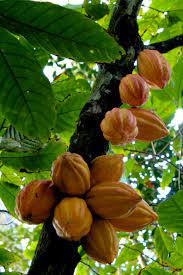
Italians have had a love affair with chocolate since it was first brought to Europe from Central America in the 16th century, by conquistador Hernan Cortes, who in 1528 brought samples of cacao to King Charles of Spain. Even before that, Columbus, on his fourth voyage to the New World in 1502, noticed how precious the cacao beans (which he called “almonds”) were to the Mayan trading ventures. As gleaned from fragments of art, writings, and pottery it was discovered that as early as 600 B.C. chocolate, made into a beverage, had been used for medicinal purposes among the indigenous Mesoamerican civilizations.
Italian businessman and adventurer Girolamo Benzoni (1519-1572), who documented his experiences of staying in the New World for 15 years, was someone who did not write so enthusiastically about chocolate, most likely influenced by his observations of what he described as Spanish greed and their treatment of the indigenous people. In 1565 he described chocolate as follows:
“It seemed more like a drink for pigs than a drink for humanity … But then, as there was a shortage of wine, so as not to be always drinking water, I did like the others. The taste is somewhat bitter, it satisfies and refreshes the body, but does not inebriate, and it is the best and most expensive merchandise, according to the Indians of that country.”
Hardly an endorsement!
Nevertheless, chocolate continued to be popular across Europe and Italy specifically, where chocolate was at various times discouraged by the Church, coveted by the nobility, or made in pharmacies and touted as an overall “health restorer” or as a remedy for kidney disease, digestive disorders, hemorrhoids, angina… Italian ingenuity in creating new recipes using chocolate did not start with Pietro Ferrero (1898-1949), who, because of the shortage of chocolate following WWII decided to try mixing whatever amount of chocolate he could obtain with the abundant supply of local hazelnuts to create Supercrema Gianduja, later to evolve into the popular Nutella spread. Nor did it start with the trailblazing female entrepreneur (and Perugia-born clothing designer ) Luisa Spagnoli, who created the Perugina chocolate factory and the hazel-nut centered Baci Perugina in 1922. Long before either Ferrero or Spagnoli were associated with innovative chocolate creations, Francesco Redi (1626-1697), physician to Cosimo III de’ Medici, was experimenting with chocolate, eventually coming up with a secret jasmine-infused chocolate for the de Medici court. His recipe was so coveted by the nobility that it was not allowed to be revealed until after his death.
Italian ingenuity in creating new recipes using chocolate did not start with Pietro Ferrero (1898-1949), who, because of the shortage of chocolate following WWII decided to try mixing whatever amount of chocolate he could obtain with the abundant supply of local hazelnuts to create Supercrema Gianduja, later to evolve into the popular Nutella spread. Nor did it start with the trailblazing female entrepreneur (and Perugia-born clothing designer ) Luisa Spagnoli, who created the Perugina chocolate factory and the hazel-nut centered Baci Perugina in 1922. Long before either Ferrero or Spagnoli were associated with innovative chocolate creations, Francesco Redi (1626-1697), physician to Cosimo III de’ Medici, was experimenting with chocolate, eventually coming up with a secret jasmine-infused chocolate for the de Medici court. His recipe was so coveted by the nobility that it was not allowed to be revealed until after his death.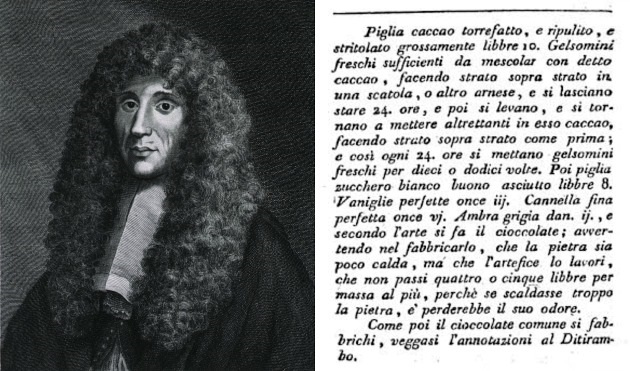
The Italian production of quality chocolate continues to be in demand throughout the world, and there are several renowned artisanal chocolate crafters across the bel paese.
Among European countries, Italy today is 7th largest importers of cocoa beans (which must be grown 15-20 degrees north and south of the equator) and is the 2nd largest global exporter of chocolate (manufactured in Italy). It is also the largest global supplier of chocolate to China. With all this chocolate one might ask how the obesity rate in Italy is still significantly lower than that of the US. It is not surprising that the answer is “moderation.” According to Market Watch, Italians consume an average of 2.4kg per capita versus the U.S. average of 4.3 kg. Italians also prefer mostly dark chocolate, which is healthier due to its lower sugar content.
According to an article in Medical News Today, dark chocolate, when eaten in moderation provides antioxidants that are said to protect against heart disease, reduce inflammation and insulin resistance, and also improve brain function.
So what to do if you can’t make it to the Eurochocolate Festival of Perugia this year (in 2022 it will run from Oct 14-23), and stroll along cobblestone streets and alleyways brimming with the scent of everything chocolate; from puzzles to personalized initials? Perhaps you might like to keep your Italian heritage salient by experimenting with your own chocolate-hazelnut creation, or Italian hot chocolate recipe, or even invite some friends over for a jasmine-infused chocolate fondue party.
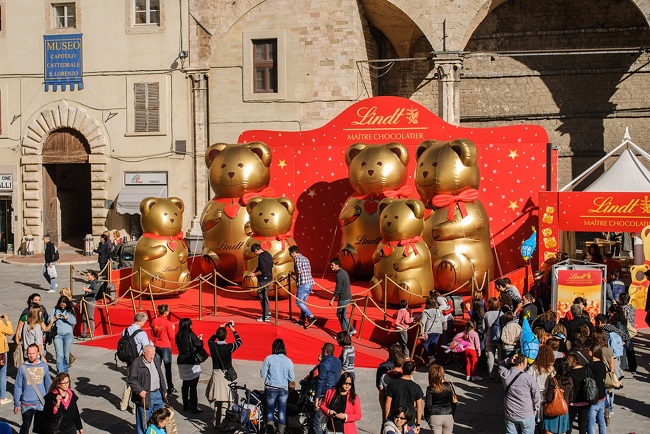
But if any of that is too much to handle right now, you can always fall back on my own simple recipe that never fails to travel me back in time to my roots, to my grandfather, and to a delightful sense of nostalgia:
Ingredients:
1 plain chocolate bar
1 slice of thick crusty bread
Directions:
Place chocolate on top of bread slice…and ENJOY.
References/For Further Reading or Viewing
Lippi, Donatella (2013). Chocolate in history: Food, medicine, medi-food. Nutrients, 5, pp 1573-1584)
Veronese, Nicola et.al (2019). Is chocolate consumption associated with health outcomes? An umbrella review of systematic reviews and meta-analyses. Clinical Nutrition 38, pp 1101-1108.
Becatti, Matteo & Florillo, Claudia (2018). Hazelnut-enriched chocolate improves flow-mediated artery dilatation via inhibition of oxidative stress. Internal and Emergency Medicine. 13: 175-1177.
Montagna, Maria Teresa et.al. (2019). Chocolate, “food of the gods”: History, science, and human health. International Journal of Environmental Research and Public Health, 16, 4960.
Benzoni, Girolamo (re-published 2016). History of the New World (Historia del Mondo Nuovo), Shewing His Travels in America, from A.D. 1541 to 1556. Leopold Classic Library
Dallen, Timothy J. (ed) (2015) Heritage Cuisines: Traditions, Identities and Tourism. Routledge Press.
The History Channel: History of Chocolate https://www.youtube.com/watch?v=twLqddk-VEw
Chocolate associations in Italy: https://www.acaicioccolatopuro.eu
What are the Benefits of Dark Chocolate? https://www.medicalnewstoday.com/articles/dark-chocolate


